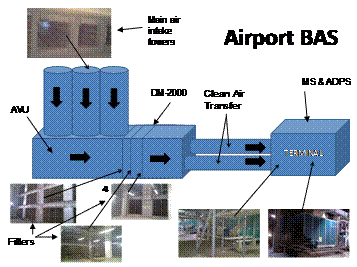Airports Use Dwyer BAS
Airports Use Dwyer BAS
Generally, airports are large complex buildings divided into numerous areas, with a number of smaller units located within them. Airports must provide a controlled environment for their visitors, while allowing scheduled maintenance within a building that is operational 24/7. Another key aspect of airports is that they must offer a high level of security for their passengers, all while simultaneously moving those travellers and their luggage rapidly through the building, in a finite amount of time.
Runways are a major source of pollution for airports that pose problems not faced in other large buildings. The main airport pollutant stems from burnt aircraft fuel, but there are many other pollutants as well. We will begin by discussing fresh air intake from a sensor supplier's point of view. Good filtration here is essential. The condition of the filters are more important in airports than with many other building applications. In a recent case, a sizeable UK airport was recently upgraded from Dwyer Magnehelic© gages and liquid manometers to DM-2000 transmitters, allowing the building automation control system to schedule filter cleanings and replacements more accurately.

Once the air has been cleaned and is on its way inside the main terminal, the next obstacle is controlling where the treated air is needed. This calls for a number of different sensors. The critical parameters that need to be measured are: temperature, humidity, CO2, and air velocity. Another vital role of the BASsystem is to conserve energy. The demand for treated air varies significantly during the 24 hour period the airport is open. Thus, to allow the most efficient use of energy, at another UK airport, Dwyer Instruments has supplied both Magnesense© differential pressure transmitters and the Series AVU air velocity transmitters to upgrade the existing building automation system to allow maximum control of variable speed fans. As part of the same installation, Dwyer also supplied the Series ADPS differential pressure switches to monitor the performance of local filters on the supply air to individual commercial units.

As the cost of energy increases and the need to meet various energy efficiency codes around the world gains (LEED in the USA, BREEAM in the UK, etc.) BAS sensor suppliers like Dwyer Instruments, Inc. are well placed with their complete product line to help building operators monitor and control their air conditioning needs. This airport BAS example is just one of many cases where the correct selection of sensors allows the building operator to improve the air quality within the structure all while still saving energy.

